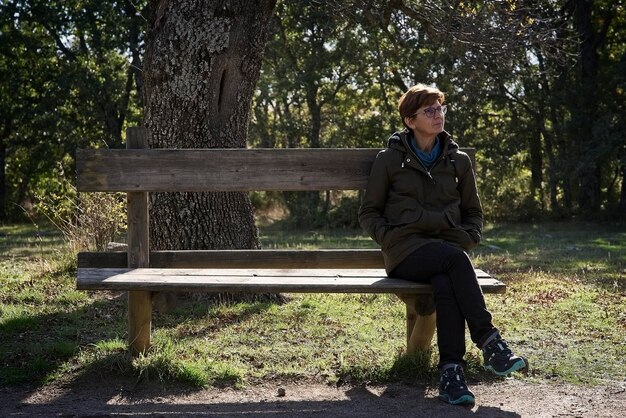Recognizing Depression: Early Signs, Intervention, and Support

Recognizing the signs of depression early is crucial for timely intervention and providing effective support, leading to improved mental wellness and a better quality of life.
Depression can be a silent struggle, affecting individuals from all walks of life. Recognizing the signs of depression: a guide to early intervention and support is the first step in helping yourself or someone you care about get the support they need.
Understanding Depression: More Than Just Feeling Sad
Depression is often mistaken for simply feeling sad or having a bad day. However, it’s a complex mental health condition that significantly impacts thoughts, feelings, and behaviors. Understanding the difference between sadness and depression is essential for effective intervention.
It’s important to recognize that depression is a medical condition, not a personal failing. It can affect anyone, regardless of age, gender, or background. Recognizing this can help reduce stigma and encourage those affected to seek help.
Key Differences Between Sadness and Depression
While sadness is a normal human emotion, depression is a persistent and pervasive condition that interferes with daily life. Here’s a look at some key differences:
- Duration: Sadness is usually temporary, while depression lasts for weeks, months, or even years.
- Intensity: Sadness is a passing feeling, while depression involves intense and debilitating feelings of hopelessness, worthlessness, and despair.
- Impact on Daily Life: Sadness might temporarily affect your mood, but depression significantly impairs your ability to function at work, school, or in relationships.
Understanding these distinctions is crucial in determining when to seek professional help. If you or someone you know exhibits persistent symptoms of depression, it’s important to consult a healthcare professional.
In conclusion, recognizing that depression is more than just feeling sad involves understanding its persistence, intensity, and impact on daily life. This understanding is the first step toward effective intervention and support.
Identifying the Emotional Signs of Depression
One of the most evident indicators of depression lies in the emotional realm. Recognizing these emotional symptoms is crucial in understanding the condition and seeking timely intervention. It’s not just about feeling “down”; it’s about a persistent shift in emotional state that affects daily life.
These emotional signs can manifest differently in each individual, making it essential to be attentive and observant. Often, these signs are subtle at first and may be dismissed as simply “having a bad day.”

Common Emotional Symptoms
Here are some common emotional signs of depression to be aware of:
- Persistent Sadness or Emptiness: A prolonged feeling of sadness or emptiness that doesn’t seem to lift, even in enjoyable situations.
- Loss of Interest or Pleasure: A noticeable decrease in interest or pleasure in activities once enjoyed, such as hobbies, social gatherings, or sex.
- Feelings of Hopelessness or Pessimism: An overwhelming sense that things will never get better, often accompanied by negative thoughts about the future.
- Irritability or Restlessness: Increased irritability, frustration, or restlessness, even over minor issues.
Recognizing these emotional signs is a critical first step in identifying depression. Understanding that these are more than just fleeting feelings can prompt one to seek professional help and support.
In conclusion, the emotional signs of depression are significant indicators of the condition, encompassing persistent sadness, loss of interest, feelings of hopelessness, and increased irritability. Recognizing these symptoms is essential for early intervention and support.
Recognizing the Physical Manifestations of Depression
Depression is not just a mental or emotional state; it often manifests physically. These physical symptoms can sometimes be the most noticeable indicators, as they directly affect the body’s functioning and comfort. Recognizing these signs can be vital in understanding the multifaceted nature of depression.
It’s important to understand that these physical manifestations are not just “in your head.” Depression can affect various bodily systems, leading to tangible and measurable physical changes.
Common Physical Symptoms of Depression
Here are some of the most common physical symptoms associated with depression:
- Changes in Appetite or Weight: Significant weight loss or gain when not dieting, or a decrease or increase in appetite.
- Sleep Disturbances: Insomnia (difficulty sleeping) or hypersomnia (sleeping too much).
- Fatigue or Loss of Energy: Persistent feelings of tiredness or lack of energy, even after adequate rest.
- Unexplained Aches and Pains: Headaches, stomachaches, or other pains that have no clear physical cause.
Recognizing these physical symptoms is crucial in identifying depression, particularly when emotional signs are less obvious. Understanding the connection between mental health and physical well-being can lead to more comprehensive care.
In conclusion, the physical manifestations of depression are essential to recognize, as they often provide tangible indicators of the condition. These symptoms include changes in appetite, sleep disturbances, fatigue, and unexplained aches and pains, emphasizing the holistic nature of depression.
The Impact of Depression on Behavior and Social Interactions
Depression significantly alters behavior and social interactions. These changes are often noticeable to those around the affected individual and can provide important clues about their mental state. Recognizing these behavioral shifts is crucial for early detection and support.
The impact on behavior and social interactions can vary from person to person. It’s essential to consider how these changes represent a departure from the individual’s usual behavior.
Behavioral Changes to Watch For
Here are some behavioral signs of depression that you should be aware of:
- Withdrawal from Social Activities: Avoiding social gatherings, canceling plans, and generally isolating oneself from friends and family.
- Neglect of Personal Hygiene: A decline in personal hygiene, such as not showering, brushing teeth, or changing clothes regularly.
- Difficulty Concentrating: Trouble focusing on tasks, remembering things, or making decisions.
- Increased Irritability or Agitation: Reacting more strongly to minor stressors and displaying increased restlessness or agitation.
Recognizing these behavioral changes can be a crucial step in identifying and addressing depression. By being observant and understanding, one can provide timely support and encourage the individual to seek professional help.
In conclusion, the impact of depression on behavior and social interactions is significant, often leading to withdrawal from social activities, neglect of personal hygiene, difficulty concentrating, and increased irritability. Recognizing these changes is critical for early intervention and support.
Early Intervention Strategies for Depression
Early intervention is key in managing and mitigating the effects of depression. The sooner someone seeks help, the better their chances of recovery and improved mental well-being. Recognizing the importance of this step is foundational for effective treatment.
The goal of early intervention is to provide support and resources before the condition worsens. This can involve a combination of lifestyle adjustments, therapy, and, in some cases, medication.

Effective Early Intervention Strategies
Here are some strategies that can be helpful:
- Seeking Professional Help: Consulting a mental health professional such as a therapist, psychologist, or psychiatrist.
- Lifestyle Adjustments: Making changes to improve overall well-being, such as regular exercise, a balanced diet, and sufficient sleep.
- Building a Support System: Connecting with friends, family, or support groups to gain emotional support and reduce feelings of isolation.
Implementing these early intervention strategies can significantly impact the course of depression. The goal is to address the condition proactively, promoting recovery and improving overall quality of life.
In conclusion, early intervention strategies for depression, including seeking professional help, making lifestyle adjustments, and building a strong support system, are critical for managing the condition effectively and improving mental well-being.
Providing Support for Someone with Depression
Supporting someone with depression can be challenging, but it’s also incredibly important. Knowing how to offer effective support can make a significant difference in their recovery journey. Recognizing the needs and challenges faced by someone with depression is crucial.
Providing support involves understanding their struggles, being patient, and offering practical assistance. It’s about creating a safe and non-judgmental environment where they feel comfortable sharing their feelings.
How to Offer Effective Support
Here are some tips for supporting someone with depression:
- Listen Without Judgment: Offer a listening ear without interrupting or offering unsolicited advice.
- Encourage Professional Help: Gently encourage them to seek professional help and offer assistance in finding a therapist or psychiatrist.
- Be Patient and Understanding: Recognize that recovery takes time and be patient with their progress.
- Offer Practical Assistance: Help with everyday tasks, such as cooking, cleaning, or running errands.
Providing support for someone with depression is a compassionate and invaluable act. By being understanding, patient, and proactive, you can help them navigate their recovery journey.
In conclusion, offering effective support to someone with depression involves listening without judgment, encouraging professional help, being patient and understanding, and offering practical assistance. These actions can significantly impact their recovery and well-being.
| Key Aspect | Brief Description |
|---|---|
| 😔Sadness vs. Depression | Depression is persistent, intense, and impacts daily life. |
| 😴Physical Signs | Include fatigue, sleep issues, and appetite changes. |
| 🤝Offering Support | Listen, encourage professional help, and be patient. |
Frequently Asked Questions (FAQ)
Sadness is a temporary emotion, while depression is a persistent condition lasting weeks or months, impacting daily life.
Look for persistent sadness, loss of interest, hopelessness, or increased irritability as key emotional indicators.
Common physical symptoms include changes in appetite, sleep disturbances, fatigue, and unexplained aches and pains.
Depression often leads to withdrawal from social activities, neglect of personal hygiene, and difficulty concentrating.
Early intervention includes seeking professional help, making lifestyle adjustments, and building a strong support system.
Conclusion
Recognizing the signs of depression and taking proactive steps towards early intervention and support is crucial for improving mental wellness. By understanding the emotional, physical, and behavioral signs, individuals and their support networks can take effective measures to manage depression and foster a path towards recovery and a better quality of life.





